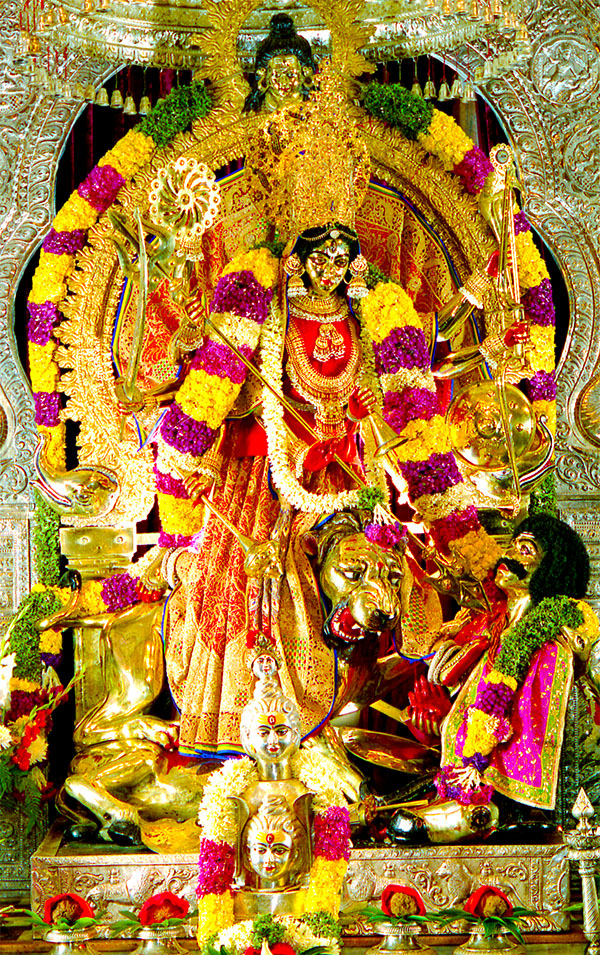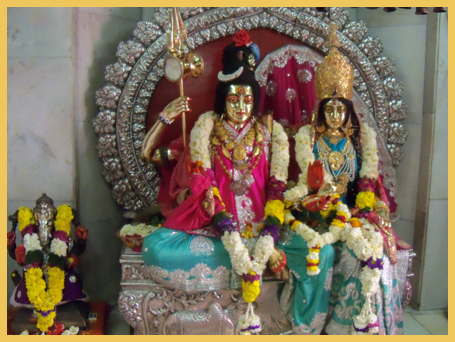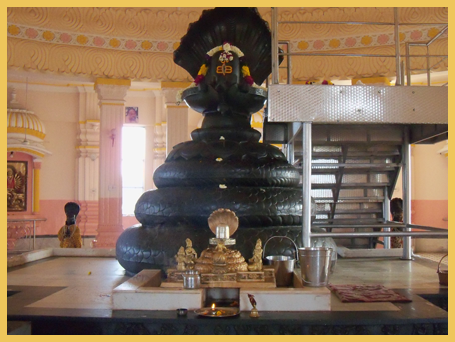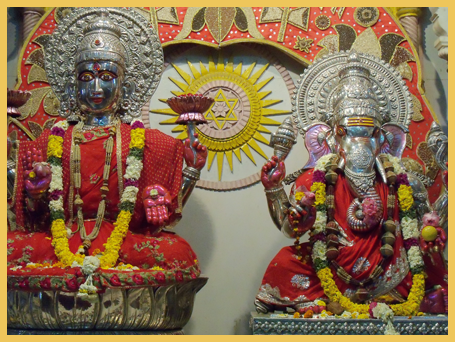
Visitors to the temple can park their vehicle in the free parking lot in the Dharamshala complex across the road and opposite the main Mandir entrance. On entering the main temple complex, one can visit the temple of lord Shiva and Maa Parvati and then come to Ram Darbar consisting of :-
After climbing up stairs, a visitor would reach the sanctum of the main deity, namely, Maa Katyayani, a form of Maa Durga. Maa Katyayani had a special appeal to Babaji. At the feet of Maa Katyayani is Lord Ganesha looking at her with devotion and attention and eager to fulfill her every wish.

After this, climbing down the steps, one reaches the hall where we have the sanctum of Maa Mahishasurmardini (open during Purnimas and Navratras only). The majestic form depicts the slaying of demon Mahishasur, an embodiment of evil by the mother goddess. One can sit in this hall and listen to Ramayan Path recited the whole day. On coming out of this hall, one reaches the Satsang hall where religious and cultural programmes take place on Sundays, Purnimas, Janamashtami, Shivaratri and Navratras. The hall has the capacity to accommodate more than one thousand people at a time. Many renowned artists have performed here in the past.
On one side of the Satsang hall is the Shayya Kaksh (Resting Room) of Maa. A long time wish of Babaji to build a Shayya Kaksh has been fulfilled and includes a silver bed, a silver dressing table, a meeting table with nine chairs for the nine devis and a wax model of Babaji in standing position. The visitor can see the above place through the glass panel.
Just outside the Satsang hall are the sanctums of Ashtbhuji (open during Navratra only) and Lord Hanuman.It is proposed to install the statue of Babaji made in Ashtadhatu in the space in between the two staircases leading to the Satsang hall. Visitors can, thereafter, enter the Matrichaya complex consisting of the Administration block, Babaji’s museum, Rath Ghar, Baradari, Nutan Bhawan complex etc. The architecture of Nutan Bhawan complex where we have the Laxmi Vinyak Temple is of South Indian Style. Artists from South India were specially called by Babaji during the construction of this complex. Beneath the Laxmi Vinayak Temple is the Langar hall (where about 4000 devotees can take Langar at the same time) and kitchen used for preparation of food on various occasions. During Navratras, more than one lakh people eat Langar here every day. Before food is served to the devotees, it is offered to Maa Annapurna.
Babaji’s Museum at present is the place where he spent his last days. In his memory, all the items used by him or given to him by his devotees have been displayed. A Wax model of Babaji in sitting posture has been placed exactly where Babaji used to sit and give darshan to his devotees.
The Rath Ghar houses the rath or the temple chariot, which is used for pujas during Navratras. #Idols of Lord Shiva, Lord Kartikeya, Lord Ganeshji, Maa Saraswatiji and Maa Lakahmiji are kept in the Baradari during Navratras for worship. In the Yagyashala, havan is performed daily during Navratras and its participants are required to observe strict austerities during the entire period. The Yagyashala have five havan kund's which have been made on the principle of Vastu Shastra and accommodate 21 couples who perform havan. From 1st day to 7th (Saptami), pujas are performed in the morning. During 8th, 9th day long havan is performed alongwith recitation of Durga Saptshati Purna Ahuti is performed on Dashmi. Adjacent to the Yagyashala is a small Baradari with the idol of Maa Durga where, Durga Saptsati paath is performed during Navratras. Behind the Yagyashala is the temple of Bhairon Baba.
A Visitor may, thereafter, go across the road and enter the Markandeya complex flanked by Maharana Pratap Bhawan (on the left) and the Trishul i.e. trident of lord Shiva (on the right) resting on the back of a tortoise symbolizing solidarity of the earth (Prithvi Tatva) the liquidity principle (Jal Tatva) and the eternal principle (Aakash Tatva). Just ahead of this is the temple containing “Sthan Devtas” (local regional deities). Behind this temple is the old Rath Ghar where the temple’s ceremonial chariot used to be kept before being shifted to the present place.


As one approaches Babaji’s Samadhi, one can see huge decorative brass bell placed in the middle of a park on the right side. This has been cast as per the desire of Babaji and about 3000 kgs of brass has been used in the process. Ahead of this is Babaji’s Samadhi, a magnificent and graceful structure where the mortal remains of Babaji rest in everlasting peace directly below the Shivlinga in the Nageshwar temple on the first floor. The Shivlinga here is above the coiled Sheshnag, representing the immortal eternal creature (lord Shiva) rising above and unfettered by the coils of time that continuously changes as well as recycles everything in the universe. Just behind and to the left of the Samadhi is Atithi Bhawan, where Babaji spent some time before shifting to Matri Chaya complex.
At this point, it is necessary to describe in brief Navratra festivities which are celebrated in the mandir twice a year during March-April,(Vasant Chaitra Navratra) culminating in Ram Navami and in September-October (Sharad Navratra) culminating in Dussehra. For the convenience of the lakhs of devotees who throng the temple during Navratras, there is adequate free parking space for scooters and cycles in the Dharamshala parking, for cars behind the Samadhi and adjacent to Markadeya Mandapam and for heavy vehicles in the open ground near Hanuman Murti. Separate in and out gates are available in each parking lot for the convenience of the motorists.
On the right of Babaji’s Samadhi is a huge hall called Markandeya Mandapam which is the result of Babaji’s desire to have a hall big enough to accommodate a very large number of people during religious functions, discourses etc. The barricaded portion on the four sides is used as holding area for the large crowds coming to the temple during Navratras. The Markandeya Mandapam is also used for solemn functions like Shanti Path and during Babaji’s Birthday. The Subway near Markandeya Mandapam connects the two portions of the mandir complex and was built to provide a safe crossing for the devotees during Navratras. The Markandeya Mandapam has the temples of Lord Vishnuji, Maa Laxmiji, Maa Annapurna, Maa Mahishasurmardini, Maa Durga and Dasham Mahavidya.
One can see an imposing statue of Lord Hanuman in the open space near Markandeya Mandapam. This is a great attraction to the devotees of Lord Hanuman and children. The flood lights offer a majestic view of the entire area during evening hours. On the right side as one stands in front of the Hanuman Murti is the Gole building, which is at present used as Sant Nagpal Public School.
